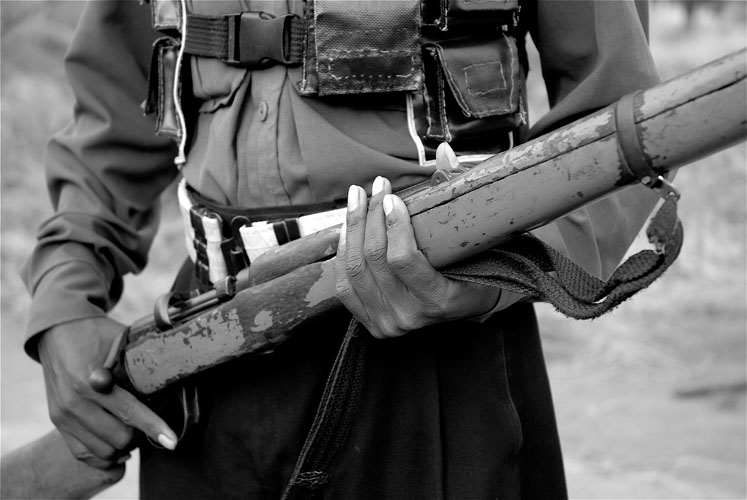
HYDERABAD, India - An aggressive push by Indian state security forces over the past two years has blunted the Maoist insurgency in the state of Andhra Pradesh, a long-time guerrilla hotbed, but many have regrouped in remote parts of neighboring states where police remain ill-equipped to combat a surge in violence.
"There is a lull in Andhra Pradesh," said K Srinavas Reddy, a Hyderabad-based expert on the Maoist movement in India. "Police intrusion, the use of informant networks and coordination with locals have weakened the Naxalites here." Maoist insurgents are also known as Naxalites after the West Bengal town of Naxalbari where a communist armed rebellion began 40 years ago.
At the heart of the state's counter-insurgency strategy is increased patrolling in areas the guerillas have typically sought refuge in along the forested northern border with Madhya Pradesh and Chhattisgarh. An elite commando unit unique to Andhra Pradesh called the Greyhounds prowls the backcountry, supported by paid informants at the village level whose intelligence has led to the arrest or killing of several leaders.
The latest report by the Asian Center for Human Rights (ACHR), a Delhi-based thinktank that monitors insurgent groups, said that Andhra Pradesh is now far behind the central Indian state of Chhattisgarh in terms of persons killed by Naxalite-related violence. Out of a total of 384 deaths - civilians, security forces, and insurgents - between January and September, Chhattisgarh accounted for 208, or 54%; Andhra Pradesh was a distant second with 59 deaths.
This is a sharp improvement from 2005, when the state witnessed 535 incidents of violence and 208 killings, according to government figures.
A top state intelligence official who requested anonymity touted the success of the Greyhounds in beating the Naxalites at their own game. The force, which numbers around 2,000 in the state, has been operational since 1990 in small bands of 15-25 commandos that are specially trained for deep forest pursuit and combat. Over the past three years, Naxalites ranks have fallen from around 1,000 hardcore members to some 400 today, according to the official.
"We had to update our skills in forest operations," he said, noting that for many years state police were regular victims of insurgent ambushes. "[The Naxalites] have been masters of the jungle, so now we have started to dominate the jungle."
Still, the government is aware that gains made in Andhra Pradesh may have contributed to an influx of guerrilla activity across its borders, particularly in Chhattisgarh. To counter this, intelligence is being shared by state agencies to coordinate tactics, and the Greyhound model is being replicated in other Naxalite-affected states such as Jharkand and Bihar where it will soon come into force.
The government is also banking on disadvantaged tribal communities on which the Naxalites rely for shelter becoming wary of the trouble they bring with them.
In July, Naxalites in the Bastar region of Chhattisgarh banned farming to protest against "the exploitation of the state's natural resources by the government". Those who defied the ban were to be given the death sentence and, according to police, at least 11 farmers in one district were killed by insurgents for working in their fields; others had their property burned or looted.
Suhas Chakma, the director of the ACHR, says that insecurity in the southernmost districts of Chhattisgarh has been compounded by the state's Salwa Judum "peace movement". Established with the intent of uniting villagers against the Naxalites, it has instead stoked violence in the region by arming poorly trained special police officers and giving them a free hand to fight. The tribals, meanwhile, are stuck in the middle.
The Andhra Pradesh intelligence official admitted he was "not in favor" of the program from the start. It should be the domain of seasoned police to bring the fight to the Naxalites, he added, as his state's successful strategy bears out.
Compared to fledgling police in Chhattisgarh, state security forces have learned from institutional experience that dates back to the late 1960s when the rebel movement first took to the Andhra Pradesh forests. There they found fertile ground among a population fed up with the vestiges of a feudal land system.
"We are the longest suffering," the official said. "There is a saying here: The oldest patient is half doctor."
But state-sponsored programs have produced unintended consequences that critics say will gradually feed another groundswell of Naxalite sympathies in Andhra Pradesh.
Greyhound personnel were reportedly behind the August 20 rape of 11 tribal women in the Visakhapatnam district. Victim testimonies gathered by rights groups say that the policemen raided their houses with charges that members of their family had links with Naxalite fighters, moving on to gang rape them. No action has yet been taken by state authorities to identify and prosecute those responsible.
Police are also accused of orchestrating "fake encounters", either killing insurgents on the pretense of defensive action or classifying the deaths of unverified criminals as Naxalites to inflate an impression of success.
A top Naxalite leader, known as Somanna, was reportedly killed in a July gun battle with police in Warangal district. However, Naxalite supporters allege he was arrested and executed in a staged manner the following day. In other affected states, Indian media have documented additional incidents in which security forces killed alleged militants who villagers claim were innocent.
The state government, for its part, rejects such allegations as part of a disinformation effort by the Naxalites to keep government forces out of villages they wish to control. Officials add that a rehabilitation program is always open to insurgents who wish to surrender, and includes a large cash sum, provided they renounce violence.
Revolutionary poet Varavara Rao, an ardent supporter of the Maoist cause, acknowledges that the Naxalite movement in Andhra Pradesh has faced setbacks. But he insists that while fighters may be depleted, grassroots support is "silent yet strong" due to the continued marginalization of tribal and lower-caste people in rural areas.
The Hyderabad native said the Naxalite insurgency has swelled and contracted over the years, likening the movement to a "phoenix bird that when killed, comes to ashes, only to rise again. In time, it will upsurge."
Reddy, the Maoism expert, said that without a development scheme that includes land reforms that favor the tribals, the insurgency will not die away. He cited a September 7 landmine attack by Naxalites on former Andhra Pradesh chief minister Janardhana Reddy and his wife during a village tour as evidence that no amount of heavy-handed action can eliminate the threat. Although the couple survived, three members of their convoy were killed.
"Ultimately, no government can get rid of this movement through force," he said. "Control it, yes, but they'll never get rid of it."



